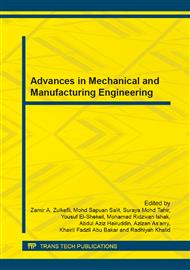p.538
p.543
p.549
p.555
p.560
p.566
p.572
p.577
p.585
Parametric Analysis of μ-Electric Discharge Machining of Non-Conductive Si3N4
Abstract:
Electric discharge machining (EDM) is an electro-thermal non-traditional machining process used to machine conductive materials. EDM process can be used to machine non-conductive ceramics by applying an assisting electrode (AE) on top of the insulating ceramics. The initial discharges occur between the tool electrode and the assisting electrode. During the spark erosion process an intrinsic conductive layer is continuously produced on the insulating ceramic. This transitional conductive layer ensures that the electric contact is sustained. However, result of parametric analysis of the EDM of non-conductive ceramics is not available. This paper presents a parametric study to evaluate the influence of five major EDM process parameters (peak current, open-circuit voltage, servo, pulse width and gap voltage) on two response variables (material removal rate and the tool ware rate) when structuring non-conductive Si3N4 ceramics using the die-sinking μ-EDM process with the help of the AE. A set of experimental trials planned with fractional factorial design with a resolution of V was performed to evaluate the primary, two-factor and quadratic effects.
Info:
Periodical:
Pages:
560-565
Citation:
Online since:
June 2014
Authors:
Keywords:
Price:
Сopyright:
© 2014 Trans Tech Publications Ltd. All Rights Reserved
Share:
Citation:


